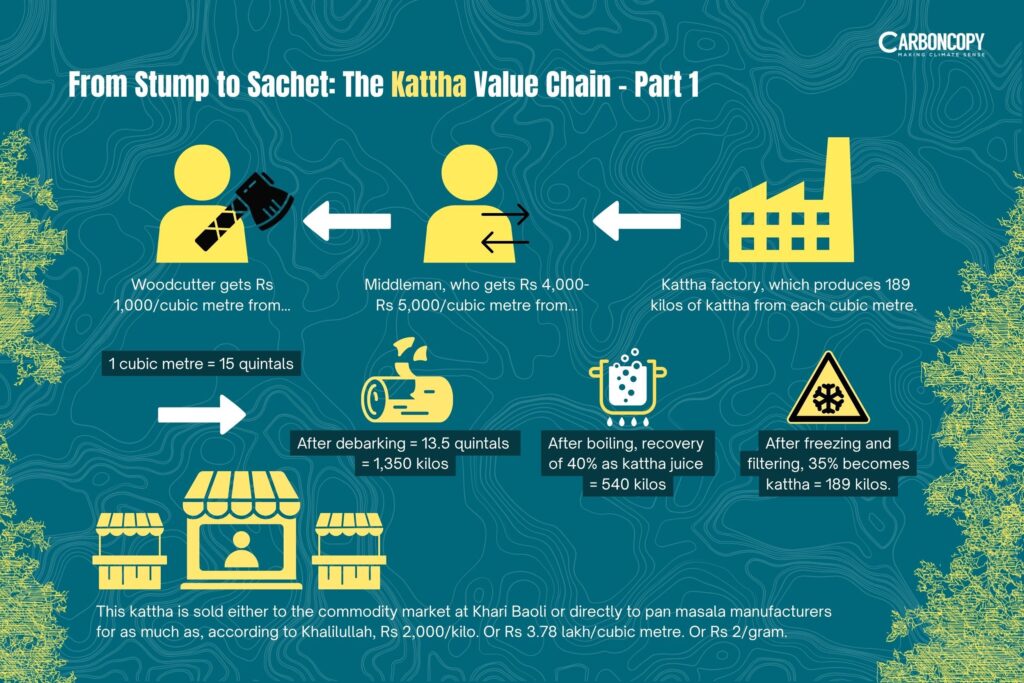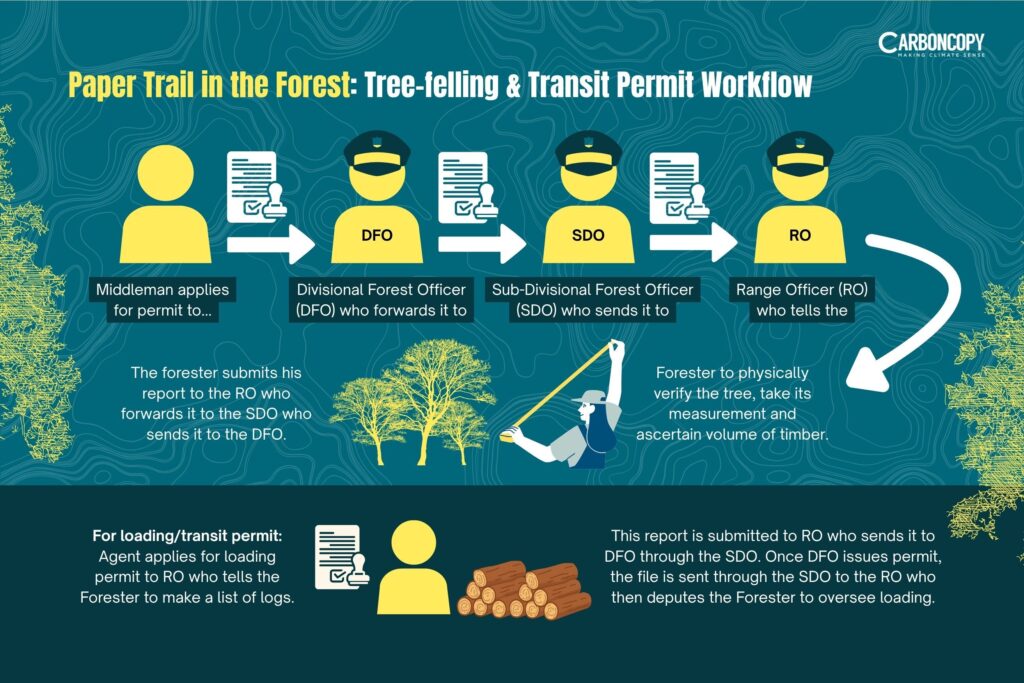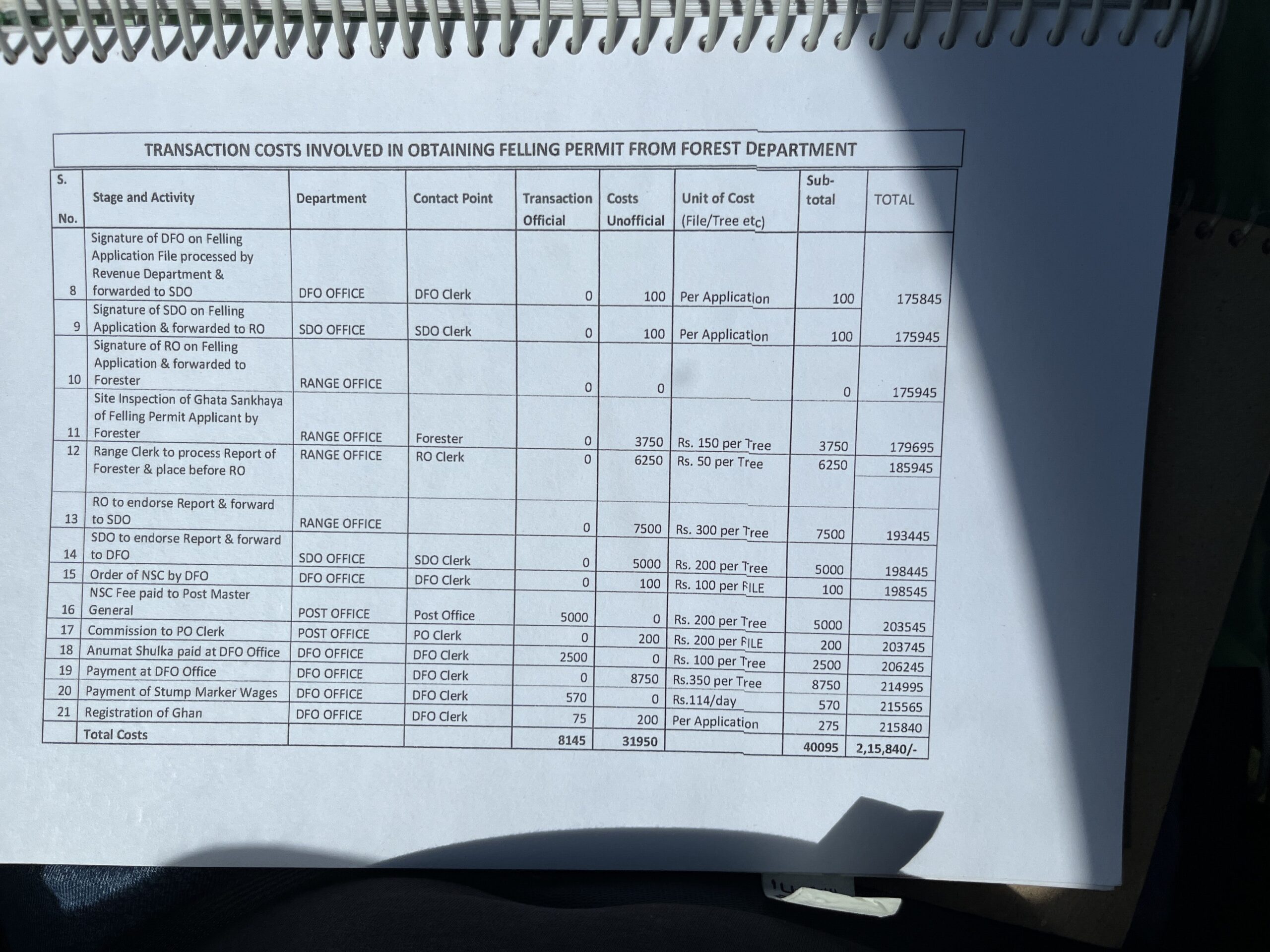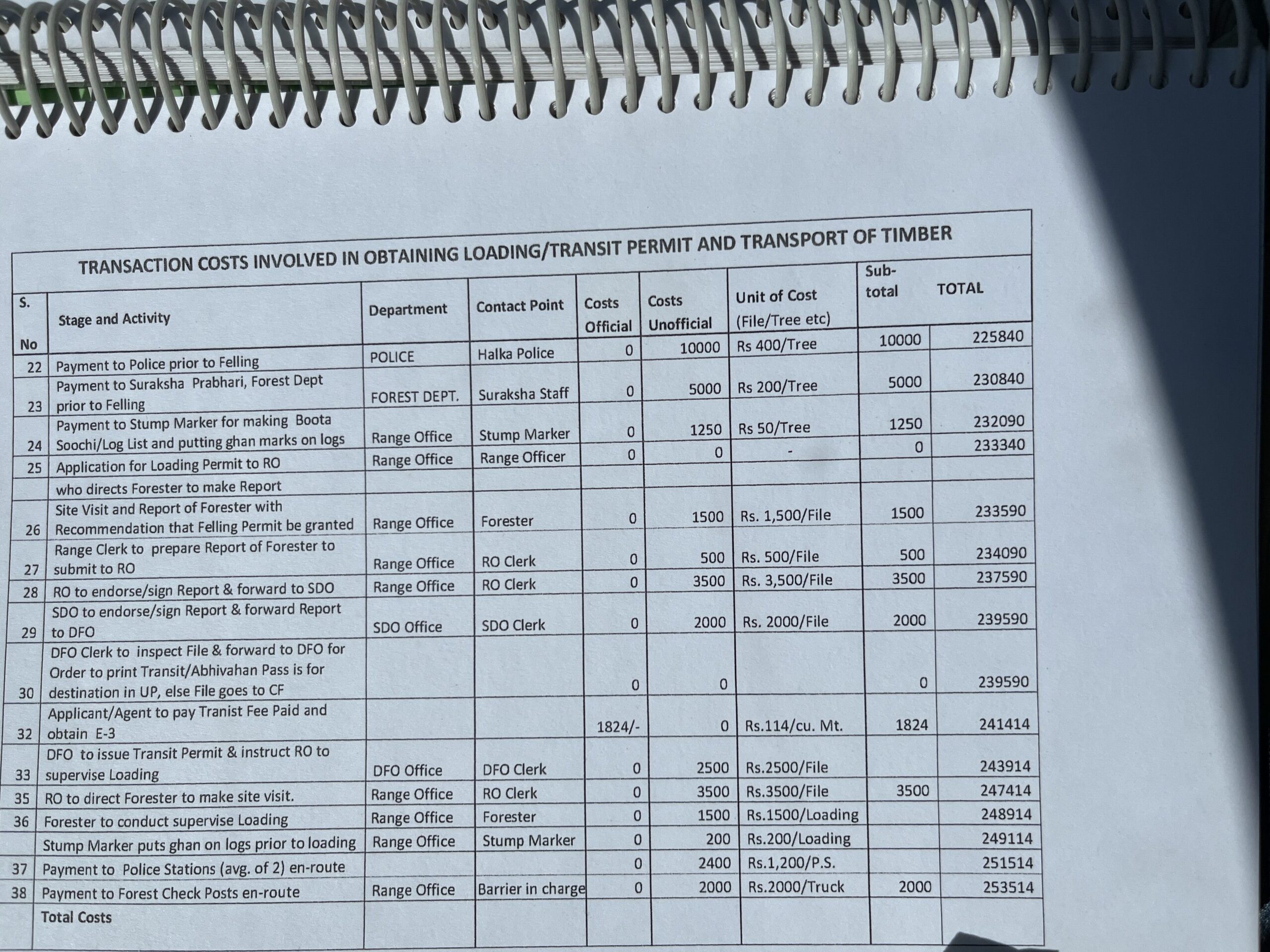In the second part of CarbonCopy’s series on India’s native forests, we trace the illicit felling of Khair trees in Uttar Pradesh’s Suhelwa Wildlife Sanctuary, and how a lucrative kattha trade, weak institutions, and complicit officials are pushing this forest, and others like it, towards collapse
Forest conservation will be one of the defining issues at COP30. Brazil, as host, is pushing for the Tropical Forests Forever Facility, a multilateral fund to reward countries that preserve their tropical forests, which it wants to launch at the end of the summit. The proposal comes at a time when forests across the world are in retreat. Logging, highways, coal mines and power plants are eating into them. Illegal timber trafficking adds its own pressure. In tandem, as governments chase carbon sinks, countries are replacing native forests with plantations. The difference is stark. As the first part of our series said, a collection of trees doesn’t equal a forest. These take millions of years to form.
India sits squarely in this paradox. Even as the country claims a rise in overall forest cover, its native forests are under pressure from both large projects and timber trafficking. Sandalwood and red sanders have long fed smuggling networks. Now, another tree is being cut down at alarming rates. Khair (Acacia catechu), the source of kattha, is a key ingredient in India’s booming pan masala industry.
This is the second part of CarbonCopy’s series on India’s native forests. The first mentioned how projects and plantations are eroding the country’s ecological foundations. This part turns the lens on timber trafficking. While the threat posed to India’s native forests by large projects has received some media attention, India’s illegal trade in timber has stayed in the relative shadows. How big a threat does it pose to the country’s forests? Is India’s forest department successfully keeping these supply chains at bay? Is the degradation of Suhelwa an aberration or a synecdoche?
Where the tigers once roamed
This was once a forest. Leopards and tigers hunted in its understory. Vultures roosted in its trees. Today, Uttar Pradesh’s Suhelwa Wildlife Sanctuary is empty. Close to 25 years have passed since the park last had a breeding population of tigers. Moving through the forest, one sees trees but hears little birdsong.
We are in the Bhabhar. These are the plains, no more than 8 to 16 kilometres in width, that stand to south of the terai, or the foothills of the Himalayas. It’s here that rivers, slowing as they enter the Indo-Gangetic plain, drop heavier pebbles and sand.
One morning in May, CarbonCopy went to a small clearing near the protected area. At one time, this patch of grass, surrounded by tall stands of trees like Sal, Sheesham, Khair and Sagaun (teak), used to draw antelopes and the big cats that preyed on them.
About two years ago, loggers felled Khair (Acacia Catechu) trees around the clearing. Capitalising on the hole in the canopy, Lantana has grown so luxuriantly that we struggle to find the stumps. The clearing itself has changed. With fewer trees rimming it, another invasive species called “Congress Grass” by locals has muscled in, edging out the grasses eaten by antelopes.
The only hint that these species once lived here now comes from Suhelwa’s website and locals’ memories. “This was supposed to be a tiger reserve,” said Niharika Singh, a local activist and a former member of UP’s State Wildlife Board. “But now, not even a khargosh (rabbit) is seen here.”
It’s a familiar script. Logging leaves gaps in the canopy; fast-growing weeds and invasives occupy those gaps, slowly reducing the forest’s capacity to feed its native species; some of which move away, and the rest slowly fade out. For this reason, the stumps — when we find them after ten or so minutes of looking — are a puzzle.
According to locals, illegal felling of Khair started in Suhelwa around 2000 and amped up from 2008-09. “In response to complaints, the first enquiry report from the Uttar Pradesh forest department came in 2008,” said Singh. Over the next 14 years, the state’s forest department produced four more reports. The last of these in 2022. Despite this phalanx of forest department reports, illicit felling has persisted.
The Grim Persistence of Timber Trafficking
Mention poaching or biodiversity trade and most people think of wild birds and animals. But just as wild animals are hunted for meat or trade, trees, too, are cut for local needs or to sell further.
Even today, both markets are staggeringly large. Wildlife trafficking is estimated at over $20 billion a year, which makes it the world’s fourth-largest illegal trade after arms, drugs and human trafficking. The market for illegally harvested timber is even higher. Interpol pegs its value as high as $152 billion a year.
The costs of this trade barely need an introduction. Through indiscriminate logging, illicit felling destroys habitats, pushing species towards extinction. By removing forests, it pushes forest-dependent communities into precarity. By evading taxes, it reduces government revenues. Given high margins, it works through criminal syndicates that suborn government officials and silence critics.
Apart from CITES (Convention for Trade in Endangered Species), the world has also tried to curb illegal timber trade through bodies like the ITTO (International Timber Trade Organisation). However, as books like Logjam: Deforestation and the Crisis of Global Cooperation show, trafficking has not just continued but grown. Unlike illegal wildlife trade, illegally sourced timber is more easily hidden within legal shipments. If processed near the point of origin, it gets yet harder to determine its legality. High profitability, born of tax evasion while selling high-value trees, has brought mafias into the trade, creating local impunity.
The outcome is one where country after country is failing to protect its forests. “In parts of the Amazon, Central Africa and Southeast Asia with large tropical forests, 50 to 90 percent of logging activity is illegal,” says a Basel Institute report.
India’s forests, too, are in the crosshairs of the illicit timber trade. Some traffickers, like those for sandalwood and red sanders, feed global demand. Others ply shorter supply chains, feeding trees to India’s furniture markets. Yet others like those selling firewood, ply supply chains that are even shorter, stretching only from forests to nearby villages.
To gauge India’s response to illegal felling, CarbonCopy picked up Khair, Acacia catechu, for a closer look. From it comes kattha, one of the chief ingredients for India’s powerful pan masala industry, a sector growing at about 4.6% each year. Produced by boiling the tree’s heartwood (debarked trunks and branches), kattha imparts the rich reddish colour that characterises pan masala and its spittle.
About 20 years ago, faced with dipping Khair stocks in Madhya Pradesh, loggers had shifted to places like Suhelwa. Today, faced with dwindling Khair in places like Suhelwa, they are now shifting again, moving from Uttar Pradesh to J&K, Himachal, Uttarakhand and parts of India’s northeast.
This pattern of rolling extraction — and the impunity which lets the trade exhaust tree stocks even in protected areas — needs to be understood.
How Khair-felling reached Suhelwa
Once the car passes Bahraich, the landscape in Uttar Pradesh changes. Trees — and the hills beyond them — fill the horizon to the north. Villages seem more sparsely populated as well.
It’s here, beyond the small town of Sirsiya, that Suhelwa lies, spanning 452 square kilometres across Shravasti, Balrampur and Gonda districts. Belying its small size, it’s an important trans-border wildlife corridor in the Terai Arc Landscape. It is, for one, the only connection between Nepal’s Royal Chitwan and Bardiya national parks. It’s, however, degrading fast.
One reason is the “pouch” (sachet) revolution in India’s chewing tobacco industry.
For centuries, Indians have eaten betel leaves filled with kattha, slaked lime and betelnut as a digestive. India had kattha factories even at the time of independence. Sourcing Khair from forests, they supplied kattha to wholesalers, who then sold it to paan shops across India.
In the 1970s, as firms began selling pan masala in sachets, this arrangement began fraying. “By the early 1980s, more packaged supari companies had come in,” said Arvind Lal, who used to run a kattha factory in Gwalior till the mid-1990s. “Unlike paan, which needed paraphernalia to make it at home (or at paan masala shops), pan masala came in sachets and was more addictive.”
As demand for pan masala grew, demand for Khair rose. From Gwalior in Madhya Pradesh, Lal saw the early fallouts of the sachet revolution.“By 1995, 14-15 companies had begun showing up for forest department auctions of Khair,” said Lal. “About 6-7 were from MP and the rest from elsewhere in the country.”
What happened next was predictable. As competition intensified, firms started by undercutting each other in forest department auctions. “If allowed to cut 15 trees, firms hand in glove with the forest department began to cut 20,” said Lal. “Others opted for adulteration and tax evasion. We found our price of Rs 800/kg of kattha undercut by rival bids as low as Rs 300/kg. By 1995, we exited the trade.”
As production rose, stands of Khair near existing kattha factories were the first to be wiped out. “Firms began to source Khair from farther away,” he told CarbonCopy. “Newer factories came up near untapped forests with Khair.” By 2000, the trade had reached the Terai Arc Landscape—and was in full swing by 2008-09.
Around this time, Uttar Pradesh made a large change in its logging policy. Until 2008, its forest department had a monopoly over logging in forests. “It ran an allotment system,” said Khalilullah, the owner of a Kattha factory in Masupur, a small town about 30 minutes from Bahraich.
“It would say: ‘This is the amount of raw material we will extract each year.’ Local factories had to sign up and pay the requisite amount whether they took the logs or not.”
In 2008, this was replaced by an open access system where private contractors could bid for logging permits once the Forest Department identified the trees to be felled. “At this time, UP had three or four kattha factories,” said Khalilullah. “Some of these had shuttered, creating lower demand than before. That was one reason for the switch to open auctions.”
It was a consequential shift. As demand outstripped supply, kattha prices were rising. Now, traders and middlemen entered the business. Unlike factories, which bought per their requirements, they also met Khair demand from buyers farther afield.
The tree, they found, was spectacularly profitable.
What happened at Suhelwa
As it moves up the supply chain, Khair’s value increases exponentially.
“Middlemen give woodcutters about ₹1,000 per cubic metre,” said a forest officer in the DFO office at Bhinga, about 40 kilometres from Suhelwa. “Kattha factories buy this wood from them for anywhere between ₹3,000-₹5,000 per cubic metre.”
On the day we met, CarbonCopy asked Khalilullah about kattha economics. His answer was startling (See chart). A cubic metre of Khair produces 189 kilos of kattha, which factories like his sell to pan masala makers or the commodity market at Khari Baoli in Old Delhi for as much as ₹2,000/kilo — an eye-popping number in a trade where fixed cost, as Lal told CarbonCopy, is “no more than ₹1 crore to ₹2 crore.”
With the manufacturing process needing little more than firewood, boilers and chillers, running cost is low as well. For this reason, much of this ₹378,000/cubic metre (2,000 x 189 kilos) is profit. CarbonCopy tried to double-check these numbers with other kattha manufacturers in Paonta Sahib, Sonepat and Delhi, but the industry is tightlipped. No one agreed to talk.
That is just the start. Kattha is an intermediate product. As the chart below shows, traders tack on their own margins. “Kattha from Himachal costs between ₹1,400/kilo to ₹1,800/kilo,” said Ranglal, who was manning the counter of a shop called Chaurasia in the bazaar. “The costliest is Banarasi Kattha. It costs ₹2,350/kilo.”
Then come pan masala companies. “Kattha accounts for 2-10% of every pan masala sachet they make,” said a senior manager at Indian Wood Products. Given high tax rates, tax evasion becomes lucrative for the pan masala industry. This also makes the sector notoriously secretive. And so, CarbonCopy couldn’t quantify the eventual price customers pay for kattha. Pan Masala websites, however, peg the cost/gram of pan masala anywhere between ₹3.5/gram to ₹4.75/gram.
By this logic, the eventual sale price of kattha is ₹3,500/kilo to ₹4,750/kilo. In other words, the final value of a cubic metre of Khair ranges between ₹6.61 lakh and ₹8.97 lakh. CarbonCopy has run these calculations past IFS officers in UP and Uttarakhand.


Given such margins, timber traffickers in Suhelwa pivoted to Khair. “Until 2009, mostly Sagaun [teak] was felled here,” said Rahim Khan, a timber trader in the small town of Bhinga. “By 2017-18, demand had moved from Sagwan to Khair.”
Seven years down, it’s hard to quantify the number of trees that have been cut. Media reports and forest department numbers extend only to seized logs. In March 2024, for instance, a raid by a forest department team led by Bahraich SDO Ajeet Pratap Singh, found 5,920 kilos of juice and 1,985 pieces from dismembered trees at Khalilullah’s factory alone. When asked by CarbonCopy, Khaliullah said he sources Khair from forest corporation auctions — a claim that is, however, disputed by local officials and activists like Singh.
On the ground, nonetheless, the effects of illicit felling are visible. In large parts of Uttar Pradesh, said a retired IFS officer in Lucknow, the tree has entirely vanished. “Khair is now no longer found in the plains — in places like Pilibhit or Bareilly,” he said “It is now found only in the foothills and the Bhabhar.” Even in the Bhabhar, though, the tree is on its way out. “In Suhelwa, old trees, some said to be as wide as 6-7 feet, are gone,” said Khan. “Most trees are now 1-1.5 ft wide.”
Between rising prices, rarity and increasing competition from other states, the trade has also begun claiming lives. In 2021, Nanhey Chauhan, a local activist working with Singh against illegal felling of Khair, was allegedly killed after he found out about a consignment of Khair.
What happened at Suhelwa. Part Two.
A large question lies here. As expected, the Indian market for pan masala is gargantuan.
And yet, this is forest timber we are talking about. Given the forest department is supposed to manage supply, why is logging so high that even IFS officers say Khair is going locally extinct? Working on this report, CarbonCopy found five interconnected answers.
One. The department could have curbed illicit felling by issuing logging permits carefully — and monitoring contractors thereafter. Neither of these has happened. In addition to stretching across UP’s Shravasti, Balrampur and Gonda districts, Suhelwa also has five ranges. Working on this report, CarbonCopy learnt that even ranges were not synchronising their logging permits. “Bhinga stopped giving permits in 2017-18 but Suhelwa continued,” said the official in the DFO Bhinga’s office. “They stopped permits only recently — about 6-7 months ago.”
The fallouts are predictable. Contractors get into the forest and log more than they should — partly to meet the forest department’s outdated volume calculations from each tree; partly due to fat margins.
This needs to be understood. India’s forest departments determine the price at which timber will be auctioned. Working on this report, CarbonCopy wrote to the UP forest department asking its current rate for Khair. By the time this article was published, we had not heard from them. In his chat with CarbonCopy, however, Khaliullah said UP’s forest corporation has set the bid price for Khair at ₹72,000/cubic metre.
Such pricing is a fraction of Khair’s eventual market value and draws India’s iron ore mining boom to mind. There, too, even as miners sold iron ore to China at ₹7,000/tonne, states like Odisha had left royalty rates untouched at ₹8 and then, at ₹27. In effect, the state saw foregone revenue while profits were pocketed by miners. With Khair too, UP loses state revenue — not just to illegal logging but also to legal felling — while traffickers make supernormal profits.
Two. The forest department is poorly supported. Understaffing is one problem. “For our seven forest beats, we should have 7 forest guards,” said a forest ranger at Suhelwa. “We have four.” In tandem, officials cracking down on Khair trafficking have been transferred, he added.
Three. Successive governments in the state have made it easier to move kattha. “Around 1980, there were a lot of kattha factories near Kanpur,” said the now-retired IFS officer in Lucknow. “There were also, however, a lot of [road] barriers in the state to check movement of wood. It was often used as an avenue for bribery, but still worked as a curb.” These barriers, he said, have been discontinued.
Four. The curious decision to not grow Khair in forest plantations. “Compared to Deodar or Sal, Khair grows much faster,” said an IFS officer at Dehradun’s Indira Gandhi National Forest Academy (IGNFA). “Sal takes 120 years to reach maturity. Pine takes 100-120. Khair grows in 30 years.” For this reason, if the UP forest department had, anticipating demand, planted Khair plantations back even in 1995, those trees would have been ready for logging now.
In effect, the forest department has repeated the mistake it made with sandalwood. While India fed global demand for sandalwood by exhausting its forest trees, countries like Australia now dominate the market by growing even Indian sandalwood in plantations.
“We knew that Khair is a commercial tree,” said BC Chowdhury, a retired professor at Dehradun’s Wildlife Institute of Management. “And yet, the forest department restricted silviculture to just 2-3 species like sal and teak. Australia now supplies sandalwood to us. Why could we not capitalise on these opportunities?” With even pan masala companies, unlike their counterparts in paper and plywood, not setting up their own plantations, India ended up feeding its pan masala habit by eating into native stock — whether pre-existing Khair trees on revenue land or those growing in forests.
Instead of addressing these gaps, Uttar Pradesh’s forest department has seen illegal logging networks — for Khair and other trees — co-opt its local staff. As the chart below shows, India’s forest department has an elaborate system of permits for felling and transporting trees.

By 2011, as the Alok Srivastava report found, unofficial payments were being extracted at each of these steps. Using Sagaun as a case study, the report says unofficial payments accounted for a whopping 93% of the middlemen’s total expenditure in getting felling and transit permits from the forest department.


This system still continues, said the forest guard quoted above, listing out the rate per tree for each of the local rungs in the forest bureaucracy. Earlier this year, in addition, a forest ranger was arrested for being a part of a group supplying Khair to a gang run by Pintu Shukla, a local Khair trafficker. Not only does this co-option stop the forest department from cracking down on the trade, it also creates a perverse incentive, driving logging underground to avoid paying rents. “The cost of illegally cut Khair is half that of legally cut Khair,” Khaliullah had said.
As it is, the low rate of schedule for Khair means that illegally-cut logs, if caught, can be released by paying ₹72,000/cubic metre. “The penalty rate is low,” said the retired IFS official. “So you don’t take the permit. If you sneak through, well and good. If you don’t, you pay that amount and get away.”
These costs, though, impinge on the economics of kattha factories. When I spoke to Lal, he concurred. “More than kattha factories, the really profitable business is the pan masala industry,” he said. “Kattha factories have to pay a share to the forest department and others. Pan masala companies, however, retain the whole margin.”
The department’s response to each of these concerns has been puzzling. It has suggested remedies like revamping girth calculations, better marking of stumps, tighter monitoring of loading permits — by even creating a software for the task. Problems like understaffing; under-equipment; low patrolling; not capturing maximal value from Khair to squeeze profits out of illegal logging; and corruption inside the department, however, have not been addressed.
CarbonCopy emailed questions to UP’s Principal Chief Conservator of Forests and the DFO of Suhelwa, asking them to comment on these concerns and allegations. This article will be updated when they respond.
For now, though, the fallouts have been predictable. UP, said the retired IFS officer, is left with no more than 5-7% of the Khair it used to have. “That is a guess,” he said. “Such studies should have been done by the Forest Survey of India but no one has commissioned them.” The next two parts of this series will get into more detail on this omission.
Supply chain dynamics, however, suggest that UP’s stock of Khair trees is falling. New kattha factories are coming up, not in Uttar Pradesh, but in J&K, Uttarakhand, Himachal Pradesh and parts of the north-east. “At this time, 20% of Khair comes from J&K,” said Khaliullah. “As much as 40-60% comes from HP. With 40 kattha factories there, it is the biggest production centre today. The rest comes from states like Uttarakhand and Haryana.”
At Khari Baoli too, traders said they get most of their kattha from “Shimla” — the capital of Himachal Pradesh.
To see how the supply chain works there, CarbonCopy went to Paonta Sahib.

